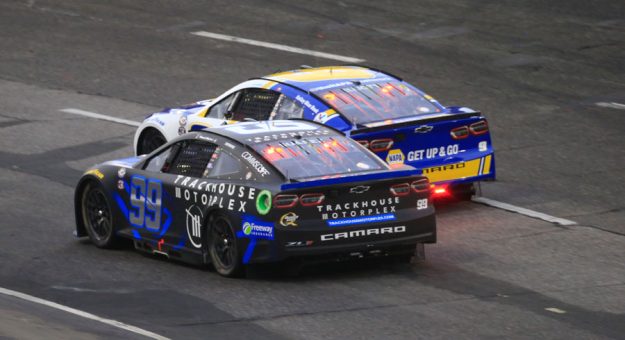During the All-Star heat races at North Wilkesboro Speedway Saturday night, NASCAR introduced something new to Cup Series competition — a “wet” tire being used on an oval track.
Though the tire was used in the Truck Series at the Martinsville (Va.) Speedway “paperclip” on April 15, Saturday marked the inaugural run for the Goodyear wet-weather oval tire in the Cup Series.
A day later, Greg Stucker, Goodyear’s director of racing, was pleased with the tire’s performance.
“Overall, it’s good,” Stucker said. “I think we proved we can get races started, maybe earlier than we normally would. We’ve also proved that we can race in conditions that historically, we said we wouldn’t race in on an oval.”
Rather than delay the first heat race by an hour or more to fully dry the track — as rain began falling prior to the 7:35 p.m. (ET) start time — NASCAR approved use of the rain tires and rolled the field to the starting grid with less than a 20-minute delay. From Goodyear’s perspective, the tire successfully proved its purpose.
“It did exactly what it was meant to do and I think it performed reasonably well,” Stucker said. “It gave guys some grip and the track was getting dry. Everything that we saw, we were very happy. No surprises.”
While the wet weather tire may eventually become the new standard with damp race conditions, Stucker emphasized the design is not intended to be used for a full race.
“That’s not the goal,” Stucker said. “The goal is to get us to the point of finishing up drying the race track. It’s so dependent on the conditions to determine how many laps you could go.”
On Saturday night, the tires lasted roughly 30 laps in the heat races before significant falloff began to occur — a lap count that Stucker feels matched Goodyear’s expectations. The leading philosophy in designing the rain tire was to bridge the gap between damp and dry conditions, while also generating enough tire falloff to increase the quality of racing.
“It’s for damp conditions. Not pouring down rain or standing water on the race track,” Stucker clarified.
It also became apparent in the heat races that the tire also allowed drivers to pick up a faster pace around the .625-mile track — the average speed in heat one (wet weather tires) was 88.641 mph, while the average in heat two (slick tires) was 85.878 mph.
This, again, was to be expected, according to Stucker.
As the tire compound is formulated to operate in cooler temperatures, it also provides more grip by generating heat faster and being “softer” than a typical slick tire. This characteristically leads to higher speeds. Stucker holds fast to the opinion that Goodyear is at a strong starting point with the tire’s development and will be able to go further with the wet-weather tire on the Next Gen car than they originally anticipated.
After finishing fifth in his heat race on the wet weather tires, Joe Gibbs Racing driver Denny Hamlin was impressed with the blueprint Goodyear had presented.
“I’m just more encouraged (that) Goodyear can build a tire that is really fast to start and falls off,” Hamlin told SPEED SPORT. “If (Goodyear) could just split the middle and say, ‘OK, we’re gonna make a compound between the slick and the rain (tire),’ you probably have way more falloff.”
Stucker said Hamlin’s comments were “spot on.”
